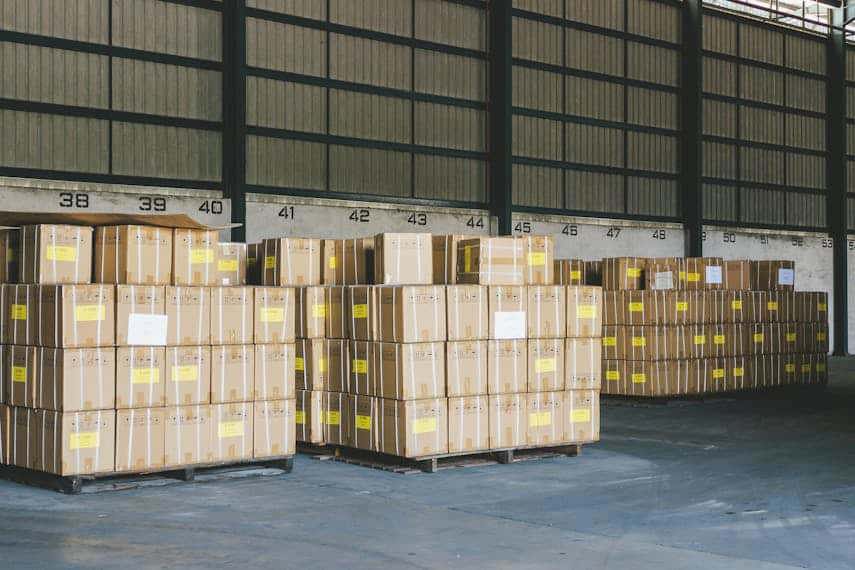
Logistics planning allows businesses to navigate challenges more effectively while seizing opportunities for growth and profitability. Without it, your organisation may struggle to keep up with demand – resulting in lost revenue and limited cash flow.
In this guide we explore the importance of logistics planning in supply chain management, how to create a logistics plan, and easy ways to optimise your logistics planning process.
What is logistics planning?
Logistics planning is the strategic coordination of activities related to the movement and storage of inventory within a supply chain. It’s an end-to-end process that involves organising, implementing, and controlling the flow of products and materials from the point of origin to the point of consumption.
Playing a crucial role in optimising supply chain performance, logistics planning aids in reducing costs, improving efficiency, and increasing competitiveness in the marketplace.
 Logistics planning is a core component of logistics management that connects strategy with execution.
Logistics planning is a core component of logistics management that connects strategy with execution.
The importance of logistics planning in supply chain management
Logistics planning plays an essential role in effective supply chain management.
With the increased cost of working as the leading consequence of supply chain disruptions, it’s critical to minimise outgoings wherever possible. Logistics planning reduces transportation, warehousing, and inventory holding costs by optimising routes, modes of transport, and storage facilities can lead to cost savings for your business.
4 key benefits of logistics planning
Logistics costs account for between 25% and 45% of total costs and up to 20% of product prices, depending on the activity and type of business. When properly implemented, the benefits of logistics planning help reduce these costs and improve your bottom line.
1. Helps optimise inventory and improve cash flow
Logistics planning prevents stockouts and excess inventory by strategically planning inventory levels and locations. This improves cash flow, reduces carrying costs, and ensures the availability of products to meet demand.
It can also help with proactive risk management, with contingency planning for potential disruptions such as natural disasters, supplier issues, or transportation delays – ultimately minimising the impact on the supply chain.
- Read more: Warehouse Logistics Best Practice Guide
2. Leads to more efficient business processes
Smoother operations can be achieved through streamlined logistics processes. In this way, logistics planning enhances operational efficiency across the supply chain.
A well-planned logistics strategy can also provide a competitive edge by improving delivery times, reducing costs, and offering superior customer service. This can strengthen your company’s position in the market.
3. Enables ongoing growth and improvement
Logistics planning involves the use of data analytics and technology to analyse performance metrics, identify inefficiencies, and make informed decisions. This enables continuous improvement and optimisation of logistics operations.
Timely delivery of products is also vital for meeting customer expectations. It ensures that goods reach customers on time and in good condition to improve customer satisfaction and loyalty.
4. Supports business sustainability
A recent report by MHI and Deloitte found that 48% of companies believe they’re under increasing pressure to improve sustainability in the supply chain.
Logistics planning can help contribute to a business’s sustainability goals by:
- Optimising transportation routes to reduce carbon emissions
- Minimising packaging waste
- Promoting efficient use of resources throughout the supply chain
 Effective logistics planning helps you meet sustainability goals by reducing waste in transportation and packaging.
Effective logistics planning helps you meet sustainability goals by reducing waste in transportation and packaging.
How logistics planning works: A step-by-step guide
Logistics planning is like a many-spoked wheel. It’s comprised of several key processes that, when aligned, contribute to a more efficient supply chain and reduced operational costs.
Here’s a quick breakdown of those constituent parts that make up effective logistics planning.
Detailed business planning
Logistics planning involves carefully crafting an effective strategy to improve efficiency along the supply chain.
Inside your warehouse or distribution centre, that means planning the layout, design, and operation to facilitate efficient handling, storage, and distribution of goods. It also involves making decisions around warehouse locations, capacity, technology integration, and order fulfilment processes.
Beyond the warehouse, logistics planning involves identifying the most cost-effective transportation routes and modes (such as road, rail, air, or sea) to ensure the timely delivery of goods to their destinations.
Inventory management
One of the biggest challenges facing supply chain operations is running out of stock. Effective logistics planning helps you minimise inventory carrying costs and reduce stockout risk.
It does this by optimising inventory levels and locations to meet customer demand. Good logistics planning ensures the right products are available in the right quantities at the right time.
Supply chain collaboration
Planning involves coordinating activities and sharing information with suppliers, manufacturers, distributors, retailers, and customers to ensure seamless integration and collaboration across the supply chain.
Logistics planning aims to enhance customer satisfaction by improving service levels and reliability. By balancing logistics operations to meet customer service expectations, you can improve on-time delivery, order accuracy, and responsiveness to inquiries or issues.
Workflow optimisation
Logistics planning leverages technology solutions ؘ– such as transportation management systems (TMS), warehouse management systems (WMS), and analytics tools – to streamline logistics operations, improve visibility, and make data-driven decisions.
Risk management
A recent Global Risk Survey found that 36% of businesses believe geopolitical tensions pose the greatest risk to the global economy. Logistics planning helps mitigate risks like these by ensuring a strategy is in place to deal with unexpected circumstances.
It involves identifying potential risks and developing contingency plans to mitigate disruptions such as weather conditions, geopolitical issues, and transport delays.
 A thoughtful logistics plan will reduce supply chain risk, improving your company's resilience during hard times.
A thoughtful logistics plan will reduce supply chain risk, improving your company's resilience during hard times.
How to create a logistics plan
To create a logistics plan that works for your business, follow the steps below.
1. Assess your requirements
Begin by understanding the specific logistics requirements of your organisation. This means identifying the types of goods to be transported, storage needs, expected volumes, and delivery timelines.
Try to ascertain where inefficiencies lie, which areas most need improvement, and the steps to take to make these improvements.
2. Define your objectives
Clarify the goals and objectives of your logistics plan.
For example, your objectives might include:
- Reducing transportation costs
- Improving delivery times
- Enhancing customer satisfaction
- Optimising inventory levels
Implement key performance indicators (KPIs) to monitor the effectiveness of your logistics plan.
Regularly review performance metrics such as delivery accuracy, on-time delivery rates, transportation costs, and customer satisfaction. Use this data to identify areas for improvement and make necessary adjustments to the logistics plan.
3. Create a transportation plan
Evaluate various transportation modes (road, rail, air, sea) based on factors such as cost, speed, reliability, and environmental impact.
Choose the most suitable modes for different types of goods and delivery requirements. 90% of traded goods continue to be shipped by sea, according to the International Maritime Organisation, which means that disruptions at key ocean trade routes can significantly impact supply chains.
Develop efficient routing and scheduling plans for transportation – consider distance, traffic conditions, delivery deadlines, and potential disruptions.
4. Plan packaging processes
Packaging is an essential part of the logistics process. It encompasses the protection of goods, storage and handling, brand identity and marketing, compliance, and cost efficiency,
Your packaging process needs to balance practicality and functionality while considering the customer experience.
5. Create a warehouse and inventory management strategy
Effective warehouse management makes it easy to track what’s happening in your warehouse.
Develop a plan to define what happens to goods coming in – where they are stored and where they need to go.
Conduct a thorough analysis of inventory levels and storage requirements to determine optimal stocking locations based on demand patterns, supplier locations, and distribution network design. Optimise inventory tracking with cloud-based inventory software and improve cash flow with demand forecasting tools.
6. Strengthen your supply chain network
Select reliable suppliers, carriers, and logistics service providers based on their capabilities, track record, and ability to meet your logistics requirements. Establish clear communication channels and agreements with each supplier.
Design a distribution network that aligns with your logistics objectives by determining the number and location of warehouses or distribution centres.
Identify potential risks such as weather events, supplier disruptions, or regulatory changes. Develop contingency plans and alternative routes to mitigate risks and ensure continuity of operations.
7. Establish a reverse logistics workflow
Reverse logistics refers to the process of managing the return of goods from the point of consumption back to the point of origin or another destination for various reasons, such as recycling, repair, or resale. This process includes activities like return authorisation, transportation, sorting, refurbishment, recycling, or disposal of returned products.
Reverse logistics is crucial to manage efficiently because it impacts customer satisfaction, operational costs, and environmental sustainability.
 Including a reverse logistics strategy in your logistics plan can ease the pain of handling customer returns.
Including a reverse logistics strategy in your logistics plan can ease the pain of handling customer returns.
5 effective ways to optimise your logistics planning process
By implementing these strategies, you can streamline your logistics planning process and gain a competitive advantage in the marketplace. Each point should be tailored to the specific needs and goals of your organisation to maximise effectiveness.
Data analytics
Leveraging data analytics can help you gain insights into your logistics operations.
Analyse historical data on transportation routes, inventory levels, demand patterns, and supplier performance. Use this information to optimise routes, reduce lead times, improve forecasting accuracy, and identify cost-saving opportunities.
Technology solutions
Investing in advanced logistics management software, transportation management systems, and warehouse management systems helps support growth and streamline processes.
These tools provide real-time visibility into shipments, inventory management, and communication with suppliers and carriers. Integration with ERP systems can also enhance data flow and decision-making.
Communication
Clear and timely communication ensures that everyone is aligned on expectations.
By improving communication and collaboration within the supply chain, you can reduce delays and improve overall efficiency in your logistics operations.
Begin by integrating internal departments such as purchasing, logistics, and sales. Then align your systems and workflows with external partners to ensure clear communication across the business.
Inventory optimisation
Implement strategies to optimise inventory levels and locations such as Just-In-Time (JIT) inventory management, safety stock calculations based on demand variability, and ABC analysis.
This will help you prioritise inventory management efforts and minimise holding costs while ensuring products are available when needed.
Continuous improvement
Foster a culture of continuous improvement within your logistics planning process.
Regularly review and analyse key performance indicators (KPIs) such as transportation costs, on-time delivery rates, order accuracy, and customer satisfaction.
Solicit feedback from stakeholders and implement feedback loops to identify areas for improvement and implement corrective actions.
What do logistics planning services do?
Logistics planning services are specialised offerings provided by logistics companies or consultants to help businesses optimise their supply chain operations. They provide strategic guidance and operational support tailored to meet the unique needs and objectives of each client.
These services typically involve:
- Analysing transportation routes: Finding the most efficient and cost-effective paths for moving goods from suppliers to customers as well as carrier selection, freight consolidation, and mode optimisation.
- Developing strategies to manage inventory levels: This may involve implementing Just-In-Time (JIT) inventory systems, setting optimal reorder points, and utilising techniques like ABC analysis to prioritise stock management based on demand patterns.
- Warehouse optimisation: Designing warehouse layouts and operational processes to maximise space utilisation, streamline workflows, and improve inventory handling efficiency. This includes determining storage zones, picking strategies, and integrating technology for inventory tracking.
- Setting achievable objectives: Establishing KPIs to monitor and measure logistics performance of factors such as transportation costs, order fulfilment rates, inventory turnover, and customer service metrics to identify areas for improvement and optimise logistics processes continuously.
